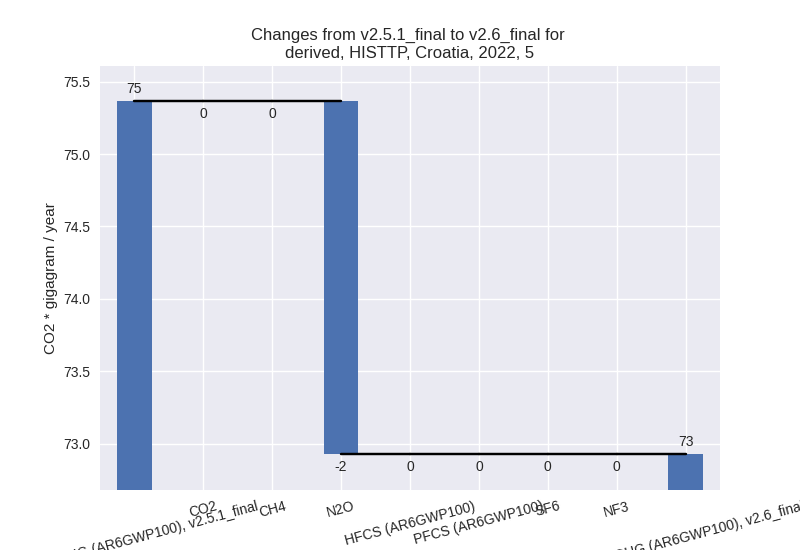Changes in PRIMAP-hist v2.6_final compared to v2.5.1_final for Croatia
2024-09-24
Johannes Gütschow
Change analysis for Croatia for PRIMAP-hist v2.6_final compared to v2.5.1_final
Overview over emissions by sector and gas
The following figures show the aggregate national total emissions excluding LULUCF AR6GWP100 for the country reported priority scenario. The dotted linesshow the v2.5.1_final data.
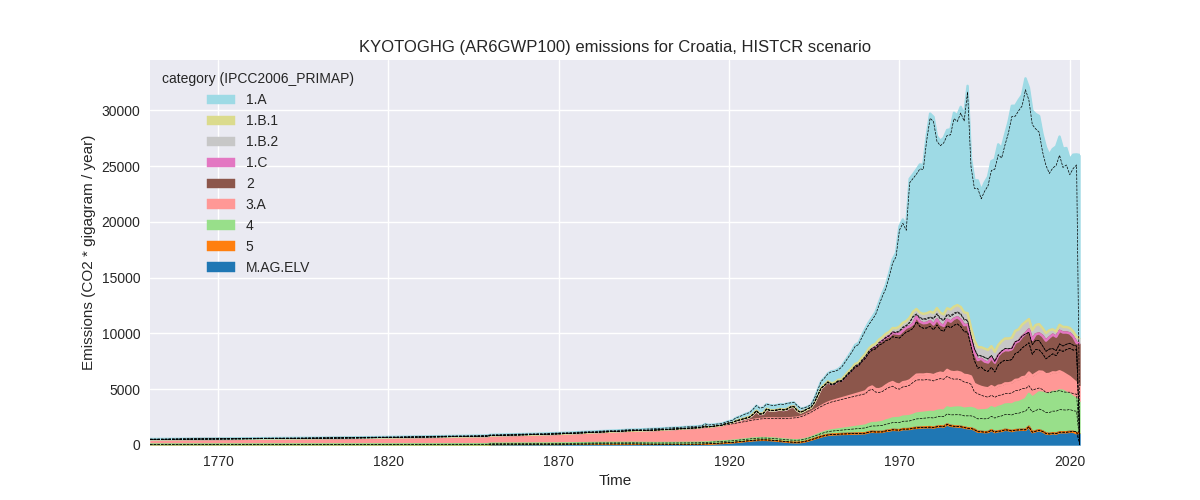
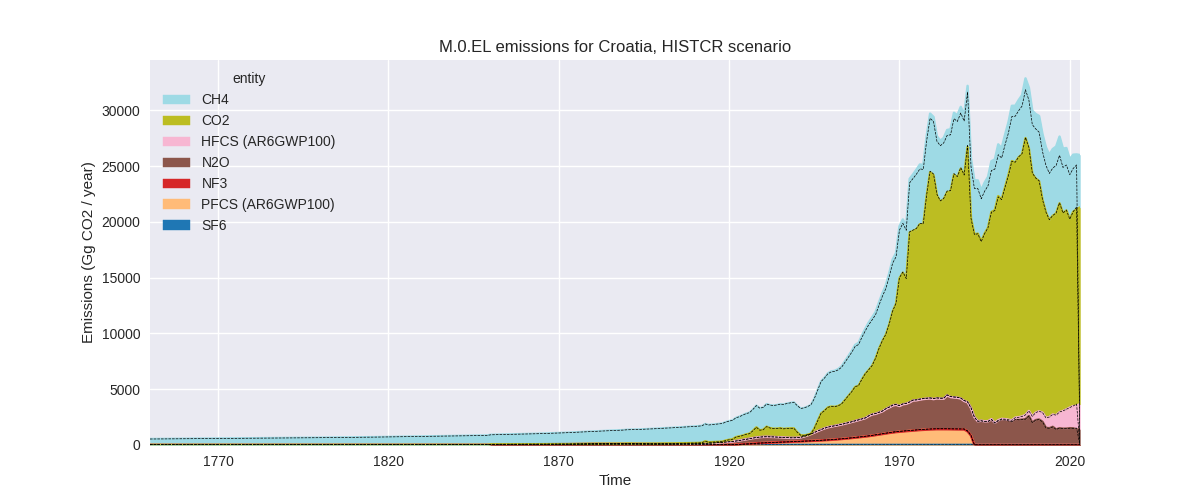

The following figures show the aggregate national total emissions excluding LULUCF AR6GWP100 for the third party priority scenario. The dotted linesshow the v2.5.1_final data.
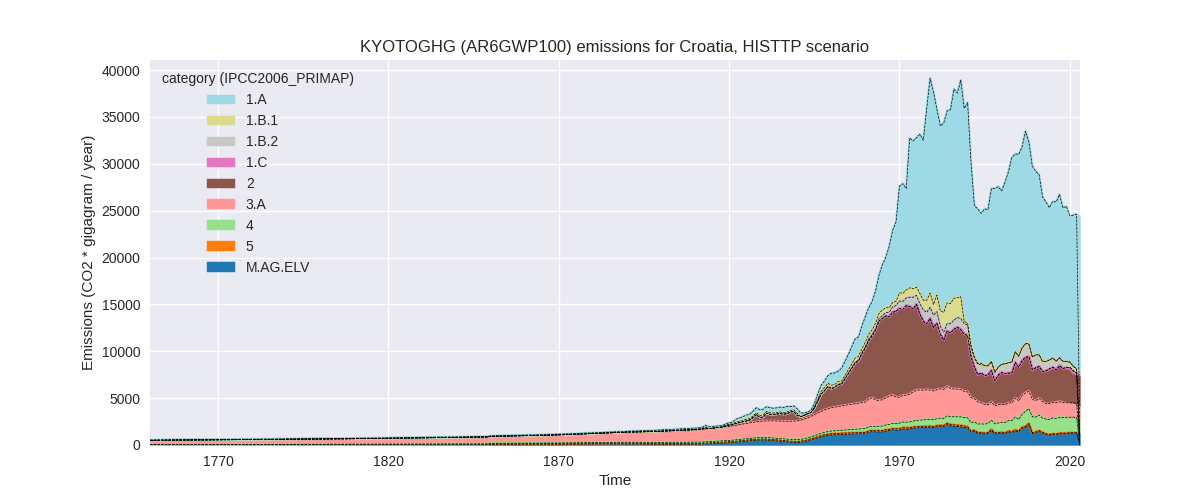
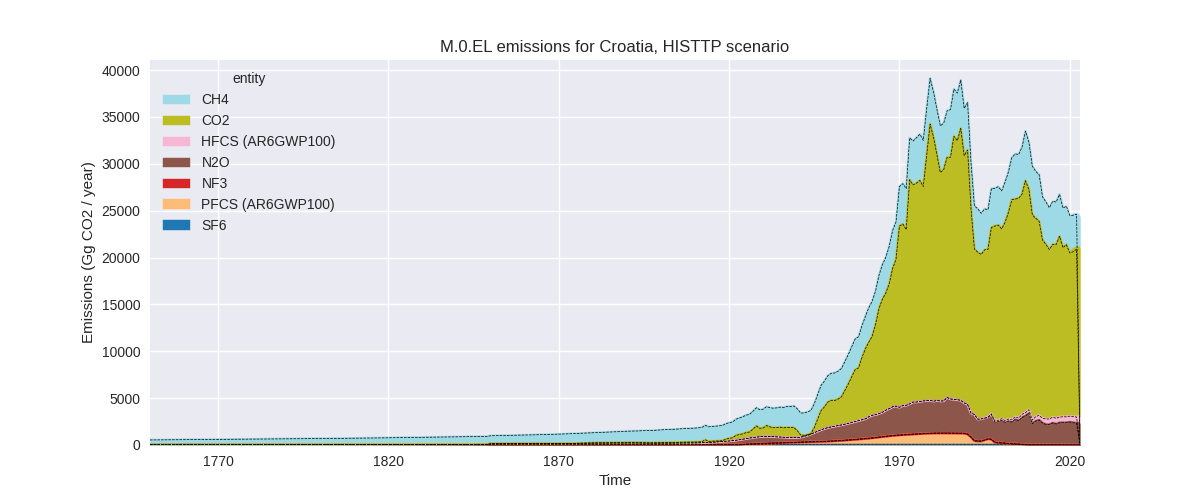
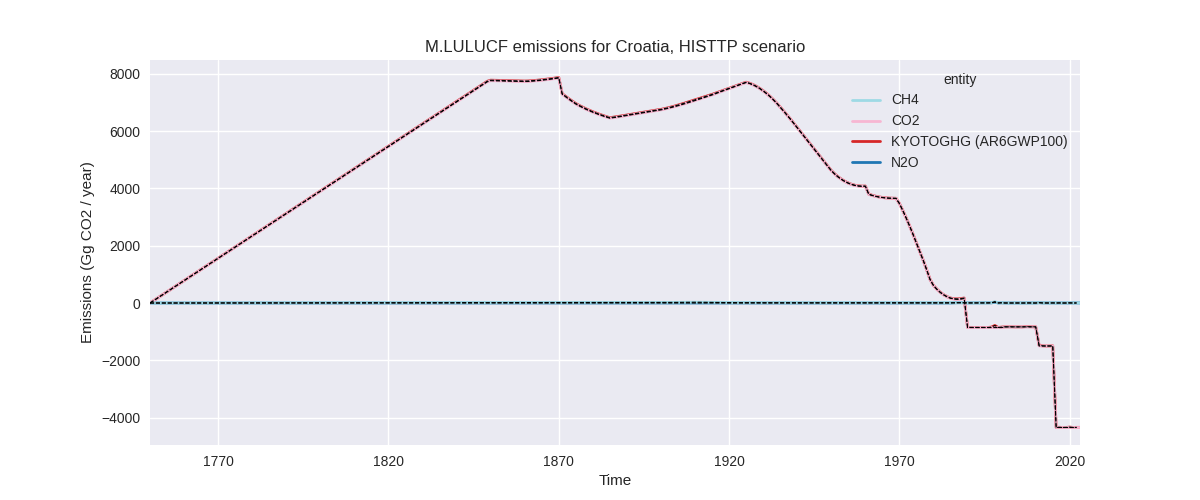
Overview over changes
In the country reported priority scenario we have the following changes for aggregate Kyoto GHG and national total emissions excluding LULUCF (M.0.EL):
- Emissions in 2022 have changed by 3.8%% (942.19 Gg CO2 / year)
- Emissions in 1990-2022 have changed by 4.3%% (1121.69 Gg CO2 / year)
In the third party priority scenario we have the following changes for aggregate Kyoto GHG and national total emissions excluding LULUCF (M.0.EL):
- Emissions in 2022 have changed by -0.1%% (-16.42 Gg CO2 / year)
- Emissions in 1990-2022 have changed by -0.0%% (-4.42 Gg CO2 / year)
Most important changes per scenario and time frame
In the country reported priority scenario the following sector-gas combinations have the highest absolute impact on national total KyotoGHG (AR6GWP100) emissions in 2022 (top 5):
- 1: 4, CH4 with 1244.21 Gg CO2 / year (72.4%)
- 2: 2, CO2 with -344.54 Gg CO2 / year (-19.5%)
- 3: 1.A, CO2 with 181.04 Gg CO2 / year (1.2%)
- 4: 1.B.2, CO2 with 165.87 Gg CO2 / year (87.2%)
- 5: M.AG.ELV, N2O with -116.16 Gg CO2 / year (-10.5%)
In the country reported priority scenario the following sector-gas combinations have the highest absolute impact on national total KyotoGHG (AR6GWP100) emissions in 1990-2022 (top 5):
- 1: 4, CH4 with 1145.31 Gg CO2 / year (75.9%)
- 2: 1.A, CO2 with -10.21 Gg CO2 / year (-0.1%)
- 3: 2, CO2 with -9.83 Gg CO2 / year (-0.5%)
- 4: 2, HFCS (AR6GWP100) with -8.35 Gg CO2 / year (-1.4%)
- 5: 1.B.1, CH4 with 6.07 Gg CO2 / year (56.2%)
In the third party priority scenario the following sector-gas combinations have the highest absolute impact on national total KyotoGHG (AR6GWP100) emissions in 2022 (top 5):
- 1: 4, CH4 with -187.91 Gg CO2 / year (-12.3%)
- 2: 1.A, CO2 with 130.66 Gg CO2 / year (0.8%)
- 3: 2, HFCS (AR6GWP100) with 38.24 Gg CO2 / year (5.9%)
- 4: 4, N2O with 4.52 Gg CO2 / year (6.1%)
- 5: 5, N2O with -2.44 Gg CO2 / year (-3.2%)
In the third party priority scenario the following sector-gas combinations have the highest absolute impact on national total KyotoGHG (AR6GWP100) emissions in 1990-2022 (top 5):
- 1: 4, CH4 with -18.43 Gg CO2 / year (-1.4%)
- 2: 1.A, CO2 with 11.41 Gg CO2 / year (0.1%)
- 3: 2, HFCS (AR6GWP100) with 1.16 Gg CO2 / year (0.3%)
- 4: 4, N2O with 0.74 Gg CO2 / year (1.2%)
- 5: 5, N2O with 0.33 Gg CO2 / year (0.3%)
Notes on data changes
Here we list notes explaining important emissions changes for the country. ’' means that the following text only applies to the TP time series, while means that it only applies to the CR scenario. Otherwise the note applies to both scenarios.
- We have added EEA 2024 inventory data.
- Waste CH4 is over 70% higher in 2022 and cumulatively because emissions in EEA2024 are higher than in CRF2023 (CR scenario)
- Cement CO2 and chemical industry CO2 are lower in 2022 due to a decline in emissions not modeled by the Andrew cement data and the EDGAR 8.0 used in v2.5.1
- CO2 in 1.B.2 is higher in 2022 because of an emission increase in EEA 2024 (CR)
- Changes in sectors 4 and 5 in the TP scenario are due to the removal of FAOSTAT data.
Changes by sector and gas
For each scenario and time frame the changes are displayed for all individual sectors and all individual gases. In the sector plot we use aggregate Kyoto GHGs in AR6GWP100. In the gas plot we usenational total emissions without LULUCF. ## country reported scenario
2022
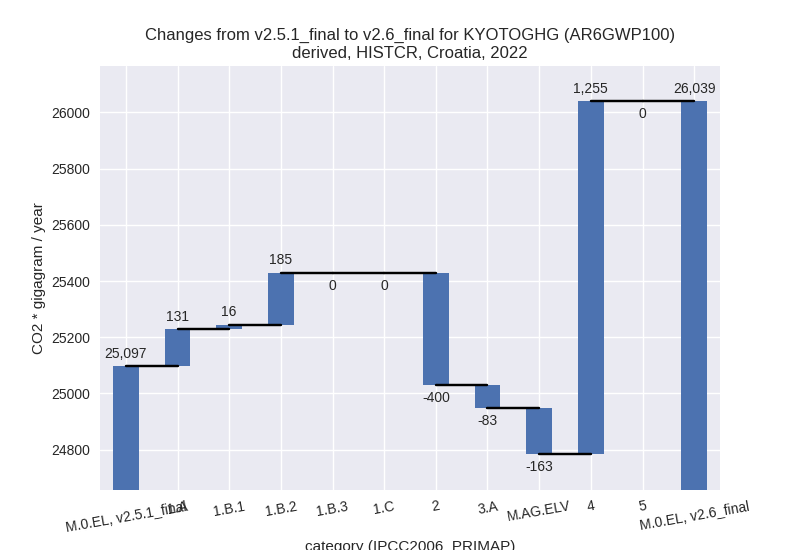
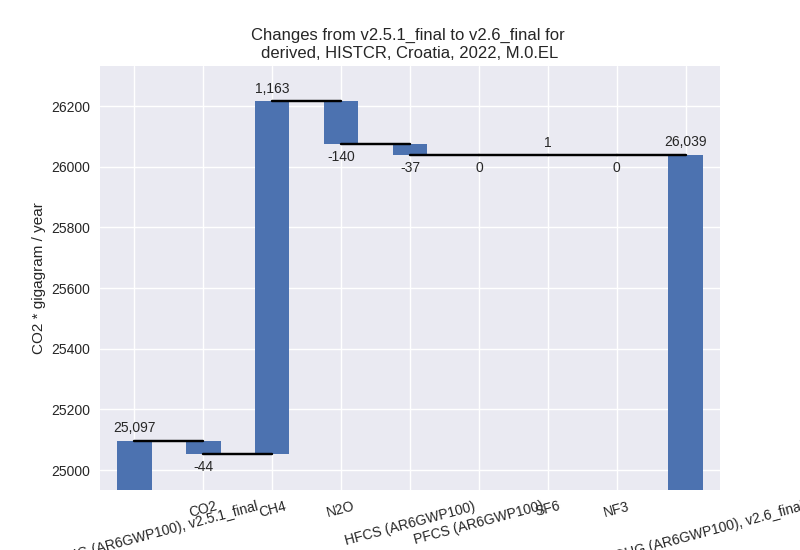
1990-2022
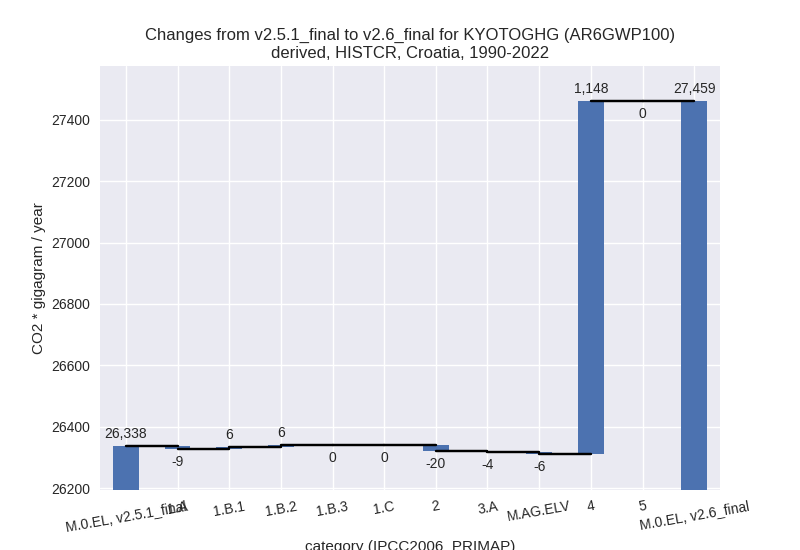
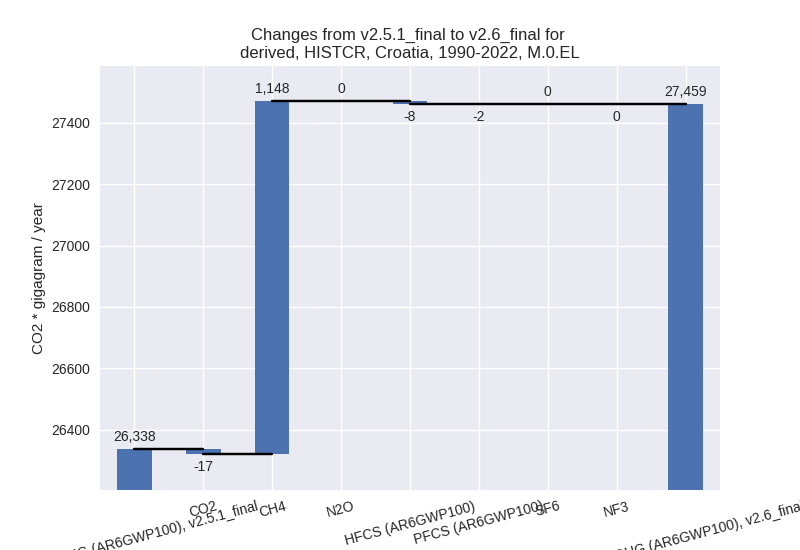
third party scenario
2022
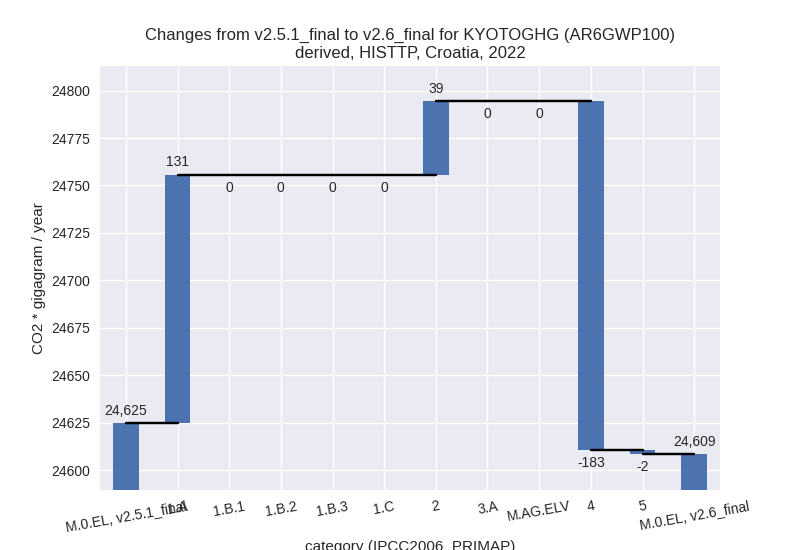
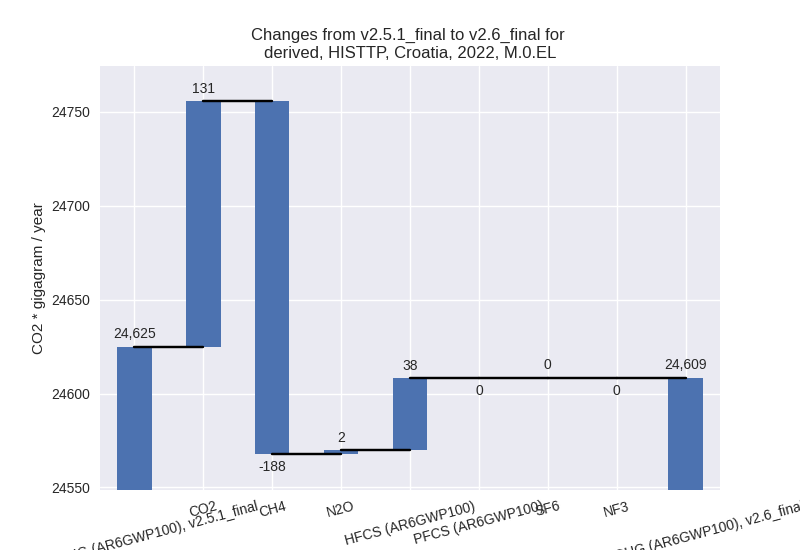
1990-2022
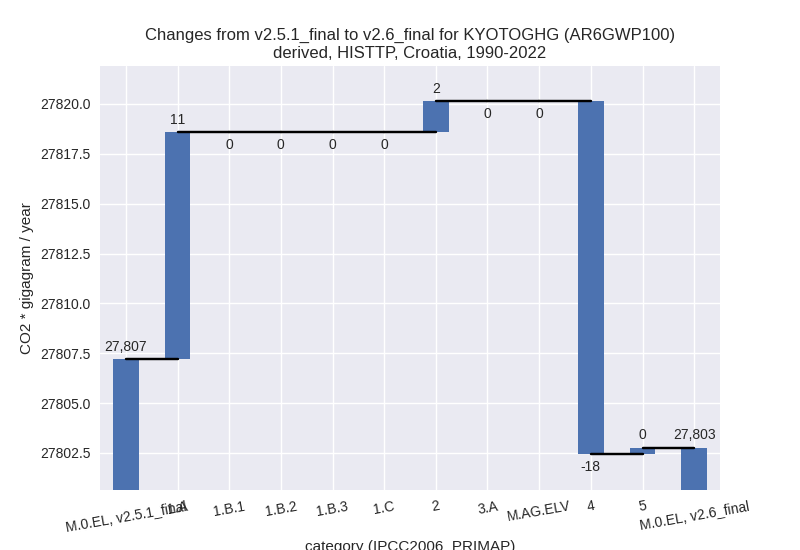
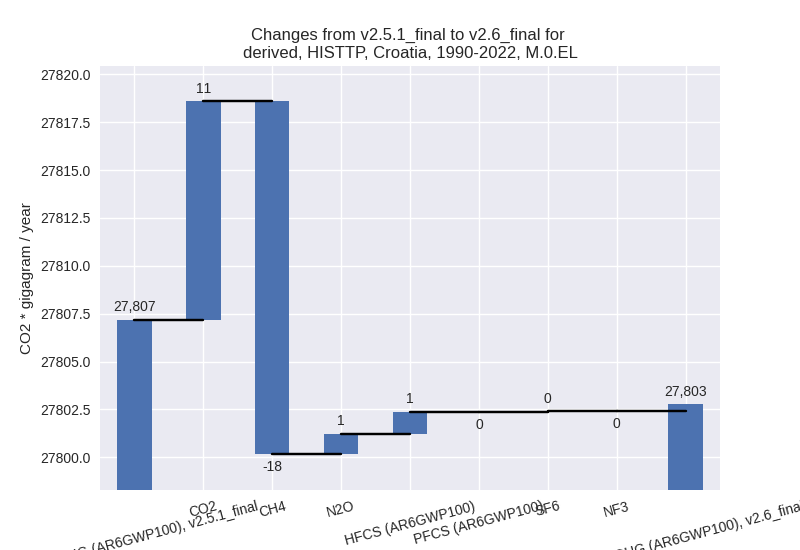
Detailed changes for the scenarios:
country reported scenario (HISTCR):
Most important changes per time frame
For 2022 the following sector-gas combinations have the highest absolute impact on national total KyotoGHG (AR6GWP100) emissions in 2022 (top 5):
- 1: 4, CH4 with 1244.21 Gg CO2 / year (72.4%)
- 2: 2, CO2 with -344.54 Gg CO2 / year (-19.5%)
- 3: 1.A, CO2 with 181.04 Gg CO2 / year (1.2%)
- 4: 1.B.2, CO2 with 165.87 Gg CO2 / year (87.2%)
- 5: M.AG.ELV, N2O with -116.16 Gg CO2 / year (-10.5%)
For 1990-2022 the following sector-gas combinations have the highest absolute impact on national total KyotoGHG (AR6GWP100) emissions in 1990-2022 (top 5):
- 1: 4, CH4 with 1145.31 Gg CO2 / year (75.9%)
- 2: 1.A, CO2 with -10.21 Gg CO2 / year (-0.1%)
- 3: 2, CO2 with -9.83 Gg CO2 / year (-0.5%)
- 4: 2, HFCS (AR6GWP100) with -8.35 Gg CO2 / year (-1.4%)
- 5: 1.B.1, CH4 with 6.07 Gg CO2 / year (56.2%)
Changes in the main sectors for aggregate KyotoGHG (AR6GWP100) are
- 1: Total sectoral emissions in 2022 are 16892.29 Gg
CO2 / year which is 64.9% of M.0.EL emissions. 2022 Emissions have
changed by 2.0% (332.60 Gg CO2 /
year). 1990-2022 Emissions have changed by 0.0% (2.73 Gg CO2 / year). For 2022 the
changes per gas
are:
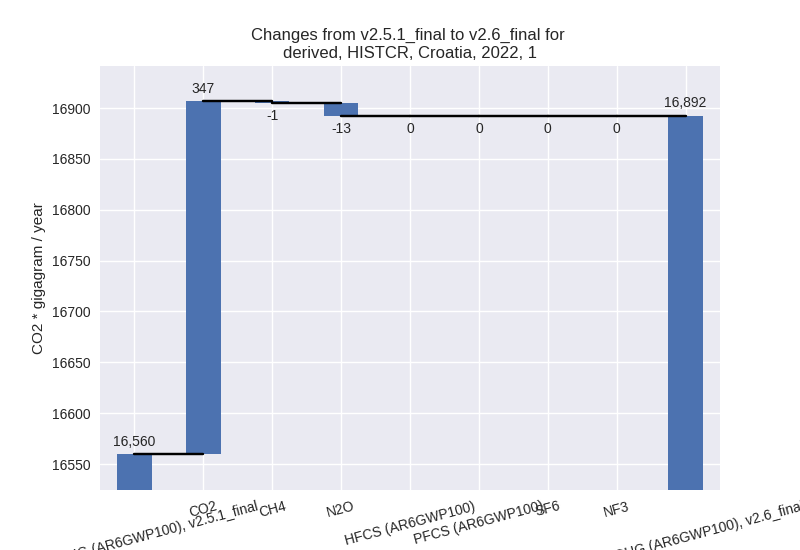
The changes come from the following subsectors:- 1.A: Total sectoral emissions in 2022 are 16364.92 Gg CO2 / year which is 96.9% of category 1 emissions. 2022 Emissions have changed by 0.8% (131.00 Gg CO2 / year). 1990-2022 Emissions have changed by -0.1% (-9.10 Gg CO2 / year).
- 1.B.1: Total sectoral emissions in 2022 are 16.44
Gg CO2 / year which is 0.1% of category 1 emissions. 2022 Emissions have
changed by inf% (16.44 Gg CO2 /
year). 1990-2022 Emissions have changed by 56.2% (6.07 Gg CO2 / year). For 2022 the
changes per gas
are:
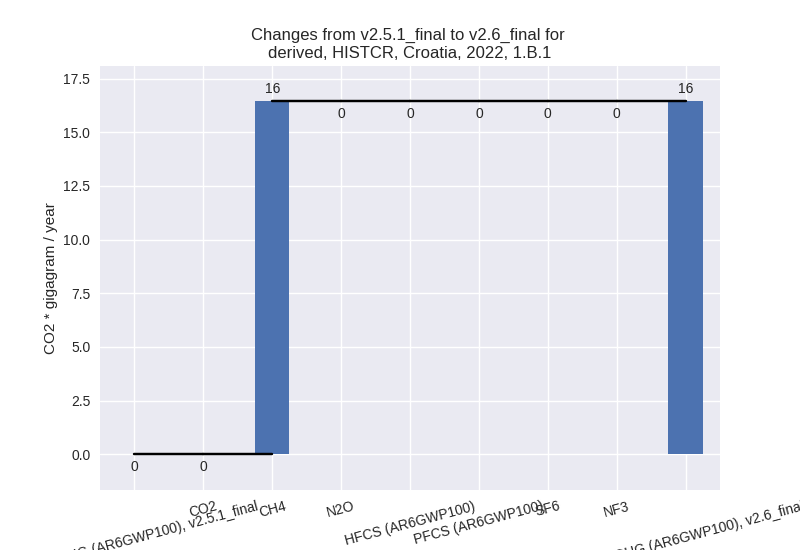
For 1990-2022 the changes per gas are: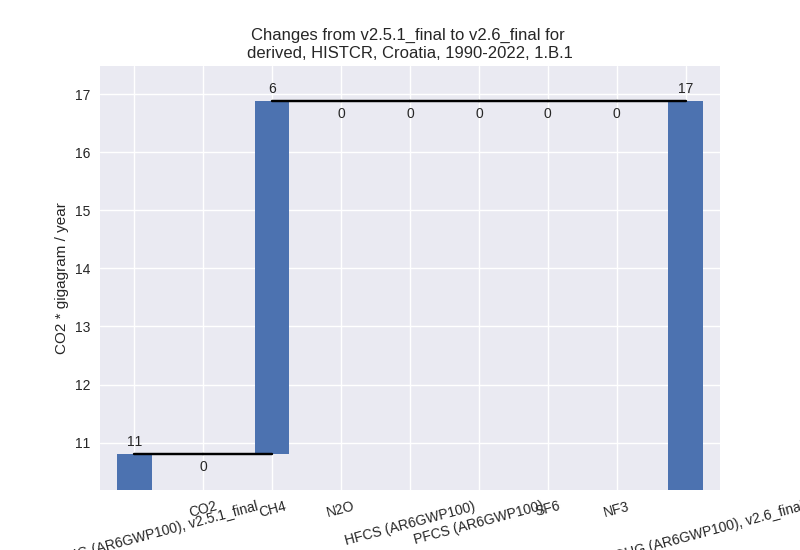
There is no subsector information available in PRIMAP-hist. - 1.B.2: Total sectoral emissions in 2022 are 510.93
Gg CO2 / year which is 3.0% of category 1 emissions. 2022 Emissions have
changed by 56.8% (185.16 Gg CO2 /
year). 1990-2022 Emissions have changed by 0.7% (5.76 Gg CO2 / year). For 2022 the
changes per gas
are:
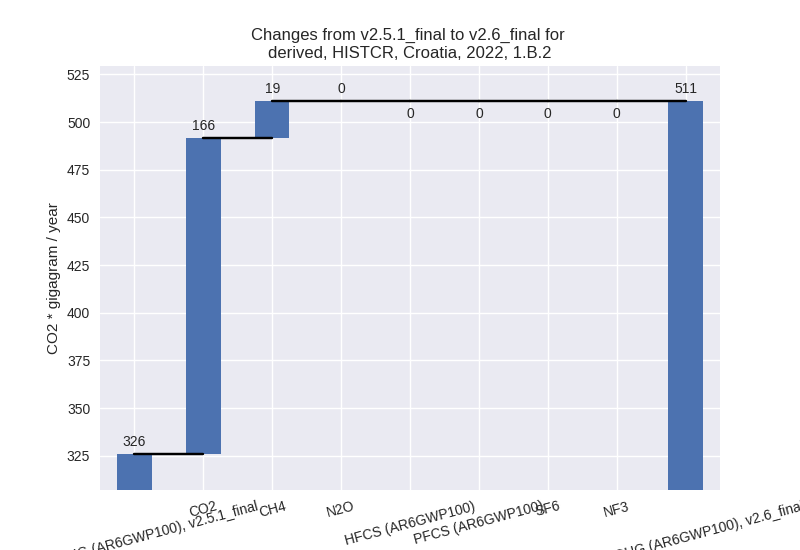
There is no subsector information available in PRIMAP-hist.
- 2: Total sectoral emissions in 2022 are 3588.87 Gg
CO2 / year which is 13.8% of M.0.EL emissions. 2022 Emissions have
changed by -10.0% (-399.76 Gg CO2 /
year). 1990-2022 Emissions have changed by -0.6% (-19.54 Gg CO2 / year). For 2022 the
changes per gas
are:
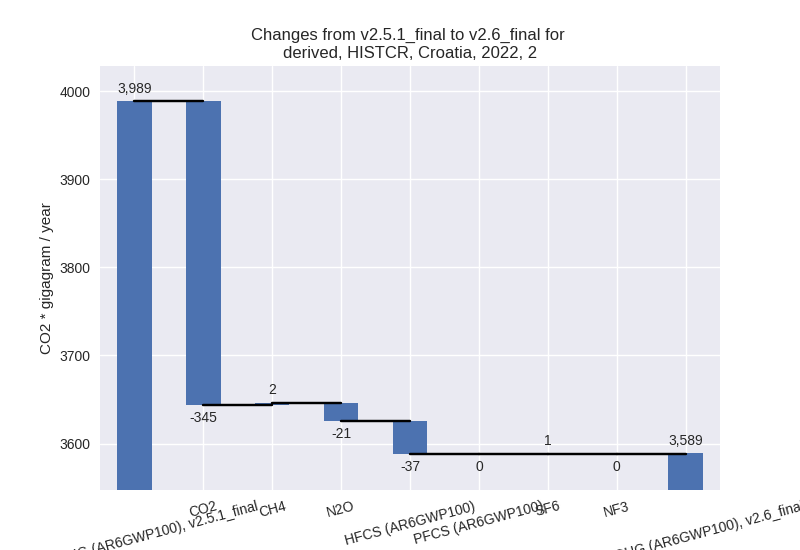
- M.AG: Total sectoral emissions in 2022 are 2492.90
Gg CO2 / year which is 9.6% of M.0.EL emissions. 2022 Emissions have
changed by -9.0% (-245.80 Gg CO2 /
year). 1990-2022 Emissions have changed by -0.3% (-9.59 Gg CO2 / year). For 2022 the
changes per gas
are:

The changes come from the following subsectors:- 3.A: Total sectoral emissions in 2022 are 1442.59
Gg CO2 / year which is 57.9% of category M.AG emissions. 2022 Emissions
have changed by -5.4% (-82.87 Gg CO2
/ year). 1990-2022 Emissions have changed by -0.2% (-3.68 Gg CO2 / year). For 2022 the
changes per gas
are:
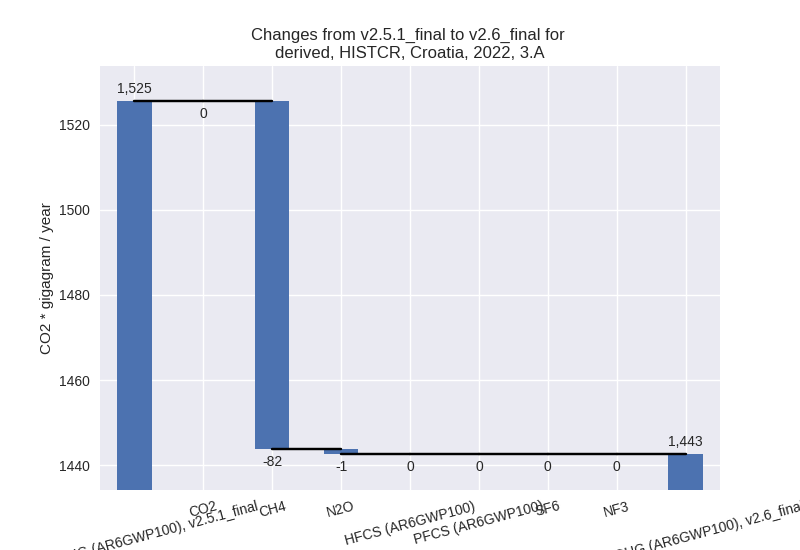
There is no subsector information available in PRIMAP-hist. - M.AG.ELV: Total sectoral emissions in 2022 are
1050.31 Gg CO2 / year which is 42.1% of category M.AG emissions. 2022
Emissions have changed by -13.4%
(-162.93 Gg CO2 / year). 1990-2022 Emissions have changed by -0.5% (-5.91 Gg CO2 / year). For 2022 the
changes per gas
are:
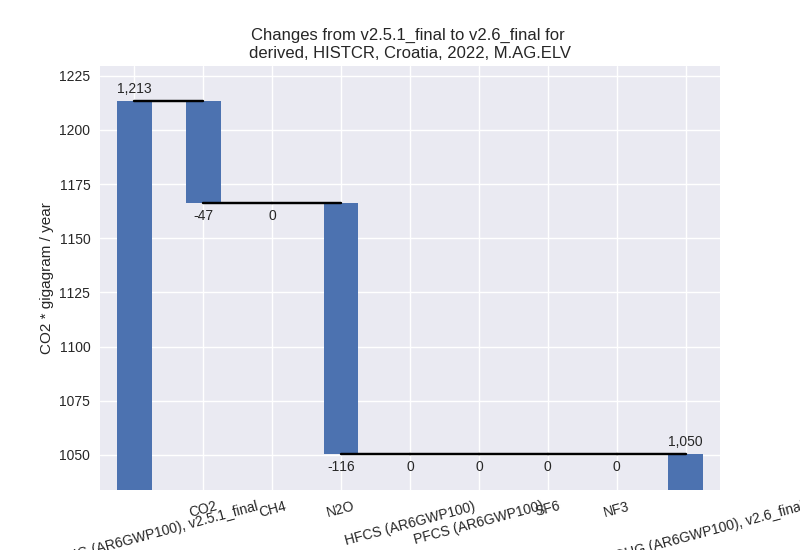
There is no subsector information available in PRIMAP-hist.
- 3.A: Total sectoral emissions in 2022 are 1442.59
Gg CO2 / year which is 57.9% of category M.AG emissions. 2022 Emissions
have changed by -5.4% (-82.87 Gg CO2
/ year). 1990-2022 Emissions have changed by -0.2% (-3.68 Gg CO2 / year). For 2022 the
changes per gas
are:
- 4: Total sectoral emissions in 2022 are 3065.11 Gg
CO2 / year which is 11.8% of M.0.EL emissions. 2022 Emissions have
changed by 69.3% (1255.16 Gg CO2 /
year). 1990-2022 Emissions have changed by 72.3% (1148.09 Gg CO2 / year). For 2022
the changes per gas
are:
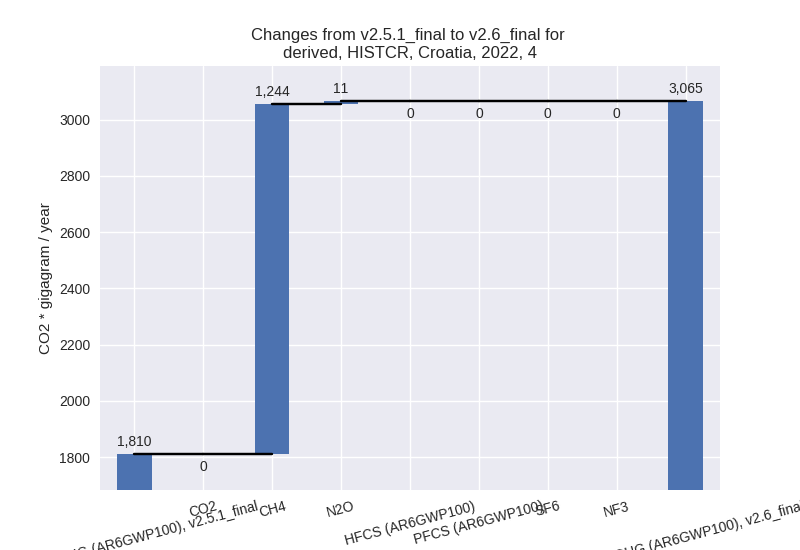
For 1990-2022 the changes per gas are: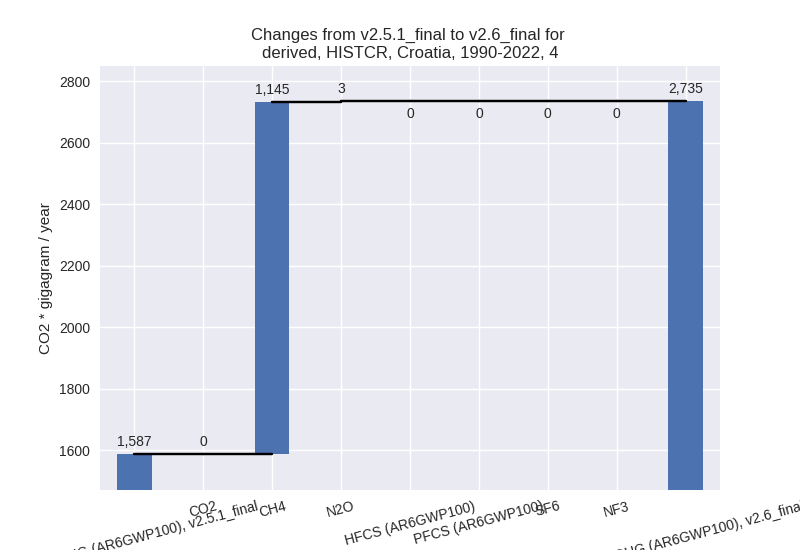
- 5: No data
third party scenario (HISTTP):
Most important changes per time frame
For 2022 the following sector-gas combinations have the highest absolute impact on national total KyotoGHG (AR6GWP100) emissions in 2022 (top 5):
- 1: 4, CH4 with -187.91 Gg CO2 / year (-12.3%)
- 2: 1.A, CO2 with 130.66 Gg CO2 / year (0.8%)
- 3: 2, HFCS (AR6GWP100) with 38.24 Gg CO2 / year (5.9%)
- 4: 4, N2O with 4.52 Gg CO2 / year (6.1%)
- 5: 5, N2O with -2.44 Gg CO2 / year (-3.2%)
For 1990-2022 the following sector-gas combinations have the highest absolute impact on national total KyotoGHG (AR6GWP100) emissions in 1990-2022 (top 5):
- 1: 4, CH4 with -18.43 Gg CO2 / year (-1.4%)
- 2: 1.A, CO2 with 11.41 Gg CO2 / year (0.1%)
- 3: 2, HFCS (AR6GWP100) with 1.16 Gg CO2 / year (0.3%)
- 4: 4, N2O with 0.74 Gg CO2 / year (1.2%)
- 5: 5, N2O with 0.33 Gg CO2 / year (0.3%)
Changes in the main sectors for aggregate KyotoGHG (AR6GWP100) are
- 1: Total sectoral emissions in 2022 are 17057.85 Gg CO2 / year which is 69.3% of M.0.EL emissions. 2022 Emissions have changed by 0.8% (130.66 Gg CO2 / year). 1990-2022 Emissions have changed by 0.1% (11.41 Gg CO2 / year).
- 2: Total sectoral emissions in 2022 are 3296.52 Gg CO2 / year which is 13.4% of M.0.EL emissions. 2022 Emissions have changed by 1.2% (38.74 Gg CO2 / year). 1990-2022 Emissions have changed by 0.0% (1.54 Gg CO2 / year).
- M.AG: Total sectoral emissions in 2022 are 2765.44 Gg CO2 / year which is 11.2% of M.0.EL emissions. 2022 Emissions have changed by 0.0% (0.00 Gg CO2 / year). 1990-2022 Emissions have changed by 0.0% (0.00 Gg CO2 / year).
- 4: Total sectoral emissions in 2022 are 1415.77 Gg
CO2 / year which is 5.8% of M.0.EL emissions. 2022 Emissions have
changed by -11.5% (-183.39 Gg CO2 /
year). 1990-2022 Emissions have changed by -1.3% (-17.70 Gg CO2 / year). For 2022 the
changes per gas
are:
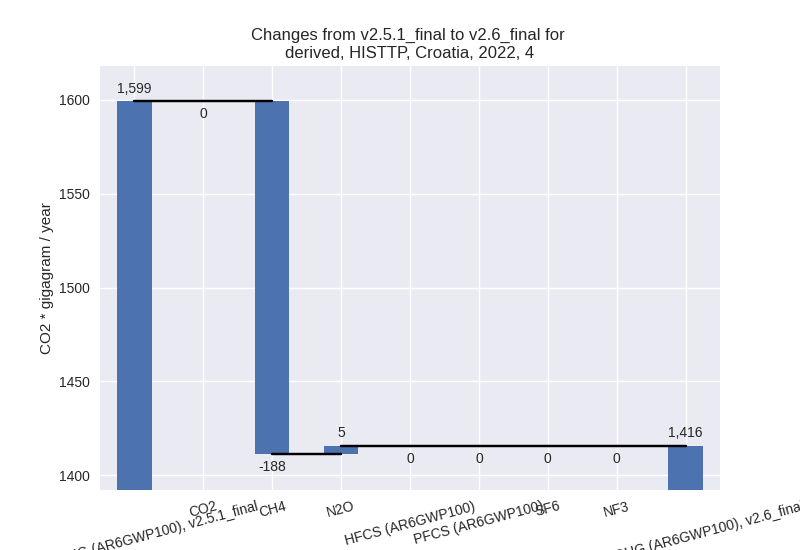
- 5: Total sectoral emissions in 2022 are 72.93 Gg
CO2 / year which is 0.3% of M.0.EL emissions. 2022 Emissions have
changed by -3.2% (-2.44 Gg CO2 /
year). 1990-2022 Emissions have changed by 0.3% (0.33 Gg CO2 / year). For 2022 the
changes per gas
are:
